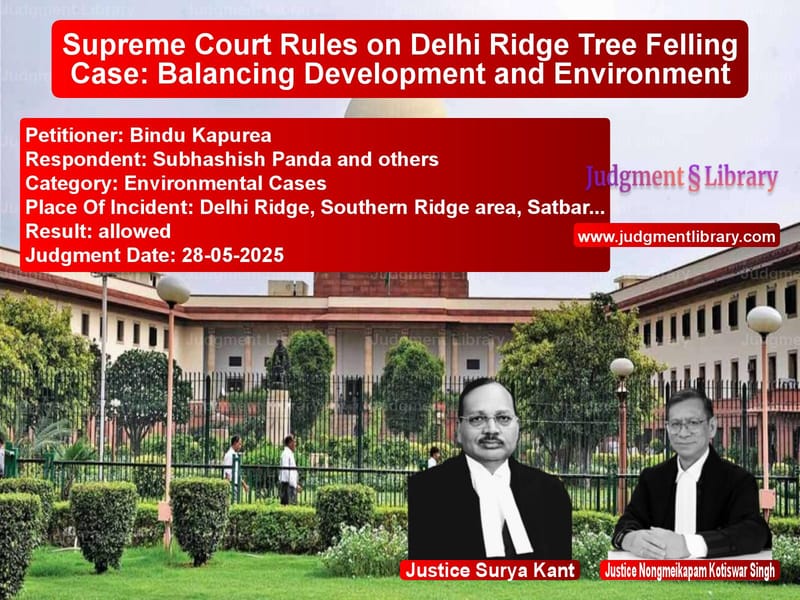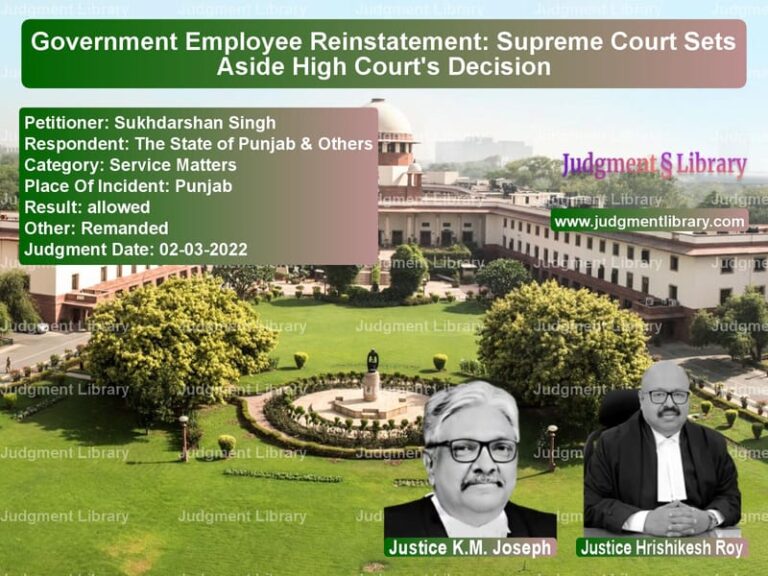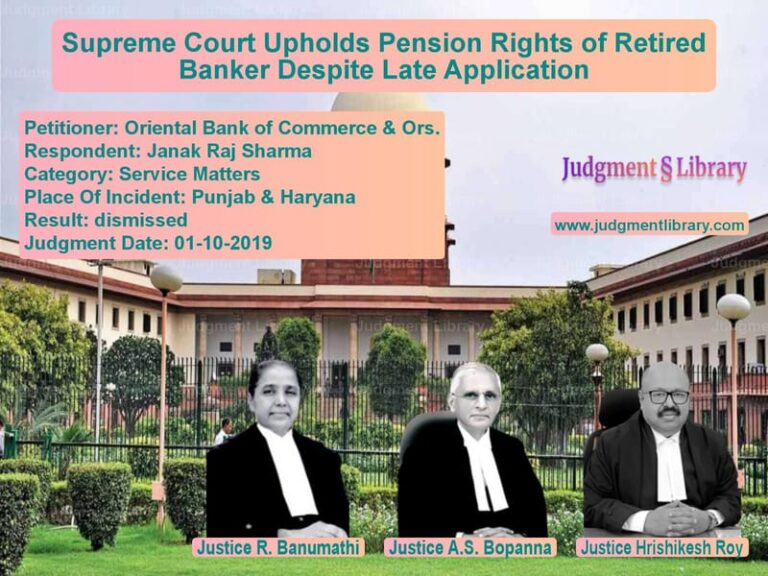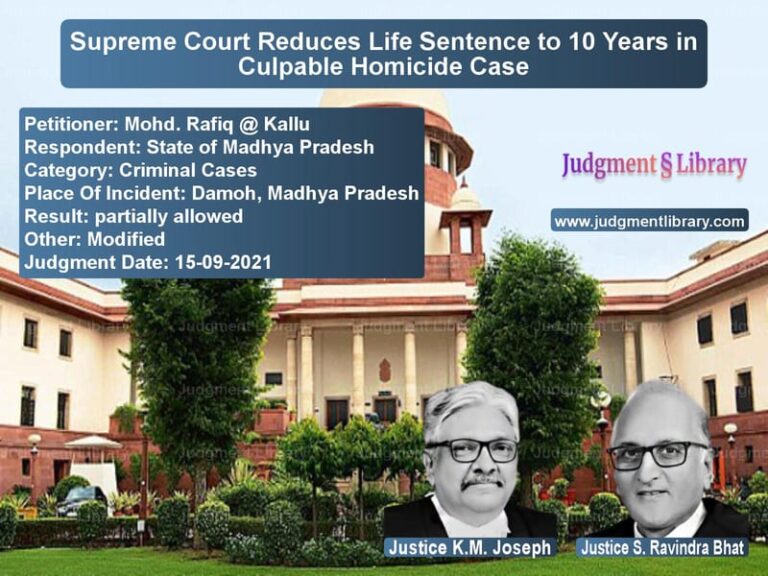Supreme Court Rules on Delhi Ridge Tree Felling Case: Balancing Development and Environment
In a landmark judgment that highlights the delicate balance between development and environmental protection, the Supreme Court of India has addressed a serious case of contempt involving the unauthorized felling of over 1,600 trees in Delhi’s ecologically sensitive Ridge area. The case, which spanned over a year of hearings and multiple affidavits, pitted environmental conservation against infrastructure development for crucial medical facilities. The Court’s ruling provides important insights into how constitutional courts must navigate competing public interests while upholding the rule of law.
The controversy began when the Delhi Development Authority (DDA) proceeded with tree felling in the Southern Ridge area to construct approach roads connecting the main Chattarpur Road to SAARC University and the Central Armed Police Forces Institute of Medical Sciences (CAPFIMS). What made this action particularly serious was that it was done without obtaining the mandatory permissions from the Supreme Court, despite the Court’s clear order dating back to 1996 that required prior approval for any activity in the Delhi Ridge area.
The Historical Context of Delhi Ridge Protection
The Delhi Ridge represents one of the oldest geological formations on the planet, dating back to the Proterozoic era. Often called the ‘Lungs of Delhi,’ this natural rock formation spanning approximately 7,777 hectares forms part of the ancient Aravalli hill range and plays a vital ecological role in maintaining the city’s environmental balance. The Supreme Court’s protection of this area dates back to 1996 when it explicitly ordered that “the Ridge is to be kept free from encroachers and its pristine glory must be maintained for all times.” The Court had further directed that “no cut off date can come in the way of relocating the J.J. dwellers which are encroaching on the Ridge” and mandated that “all encroachers must be shifted from the Ridge before October 31, 1996.”
Over the decades, the Court has consistently reinforced this protection through various orders and the establishment of specialized bodies like the Ridge Management Board (RMB) and the Central Empowered Committee (CEC) to monitor environmental conservation efforts. This long-standing judicial protection made the DDA’s actions in 2024 particularly egregious.
The Unfolding of the Contempt Case
The case came to light when the petitioner, Bindu Kapurea, discovered extensive tree-felling activities in the Satbari area of South Delhi in February 2024. Upon investigation, it emerged that the DDA had begun clearing the forest area on February 16, 2024, despite not having obtained the required permissions from the Supreme Court. What made the situation more serious was that when the DDA approached the Court on March 4, 2024, seeking permission for the same tree felling, they failed to disclose that the trees had already been cut.
The Court expressed grave concern about this concealment, noting that “the DDA’s actions of unauthorised felling of more than 1100 trees constituted a shocking disregard for the Rule of Law and amounted to interference with the administration of justice.” This led the Court to initiate suo motu criminal contempt proceedings against the responsible officials.
The Legal Arguments and Positions
Mr. Gopal Sankaranarayanan, the learned Senior Advocate appearing for the petitioner, argued strongly against the DDA’s actions, emphasizing that “there was a deliberate and coordinated attempt to conceal material facts from this Court.” He pointed out that “the felling of trees had not only commenced on 16.02.2024 but had also been wilfully carried out and completed over a span of ten days, without obtaining permission from either this Court or the relevant statutory authorities.” The petitioner’s counsel also raised concerns that “the road was sought to be widened despite the presence of an already functional roadway, with the underlying intent of facilitating access to private residences and farmhouses of affluent individuals in the vicinity of CAPFIMS.”
On the other side, counsel for the DDA and GNCTD, including Mr. Maninder Singh, Mr. Vikas Singh, and others, acknowledged that “the DDA officials had defied the orders of this Court and that contempt had been committed.” They explained that the controversy “appears to have stemmed from a misunderstanding among DDA officials, who, upon receiving certain in-principle approvals from the Government, erroneously presumed that all necessary clearances—including from this Court—had been obtained.”
The Court’s Legal Analysis and Reasoning
The Court began its analysis by emphasizing the seriousness of contempt powers, noting that “this Court enjoys wide and sweeping powers to punish individuals found guilty of interfering with or obstructing the administration of justice—an act that squarely falls within the definition of contempt not only under the Contempt of Courts Act, 1971 but most importantly, under Article 129 of the Constitution of India.” The judgment further elaborated that “the majesty of law is supreme and is unequivocally recognised by the Constitution through the conferment of plenary powers of contempt upon this Court.”
The Court identified two distinct aspects of the contempt: “first, the simpliciter non-compliance of this Court’s order dated 09.05.1996, which mandated obtaining prior permission for the felling of trees; and second, the deliberate concealment from this Court of the fact that tree felling had already commenced.” While the Court acknowledged that the first aspect might have stemmed from administrative confusion, it found the second aspect “entirely indefensible.” The Court stated that “the conscious non-disclosure of material facts before this Court during the course of proceedings strikes at the very heart of the justice delivery system. It contaminates the sanctity of judicial proceedings, may cause irreversible prejudice to the opposite parties, and carries the potential to result in erroneous precedents being laid down.”
Despite finding clear contempt, the Court took a nuanced approach, recognizing that “the underlying objective—namely, to facilitate improved access through broader approach roads for CAPFIMS and other public institutions—appears, does not seem to be in bad faith and certainly not to defy the authority of this Court.” The Court distinguished between “mala fide abuse of power and genuine administrative misjudgement” and placed the present case in the latter category.
Balancing Competing Public Interests
The Court’s judgment demonstrates a sophisticated balancing of competing public interests. On one hand, the Court recognized the critical importance of CAPFIMS as “a tertiary care hospital to cater to the medical needs of personnel serving in paramilitary forces who, in the discharge of their duties to the nation, are frequently exposed to grave risks and injuries.” The Court emphasized that “ensuring access to quality medical care is not a privilege but an imperative necessity, one that is both essential and urgent” for the families of paramilitary personnel who “routinely place themselves at risk to protect the nation and defend its borders under extremely harsh conditions.”
On the other hand, the Court expressed deep concern about the environmental damage, noting that “the reckless decimation of a substantial portion of the Delhi Ridge, carried out without any discernible effort to mitigate environmental harm, has resulted in an alarming loss of biodiversity.” The Court reminded everyone that “a forested area is not solely a collection of trees—it is a delicate and intricate ecosystem comprising of mammals, migratory birds, amphibians, critters and countless other life forms that together inexplicably contribute to the region’s ecological balance.”
Faced with this difficult choice between environmental protection and essential infrastructure, the Court acknowledged that “the establishment of CAPFIMS, the felling of trees, and the construction of approach roads are now fait accompli. While it may be theoretically possible to contemplate a reversal of these actions, such a course is practically untenable. In our view, the die is cast, and what is done cannot now be undone—any refusal to put institutions like CAPFIMS to optimal use or to undo road construction at this stage risks not only undermining public interest but also squandering significant public resources.”
The Court’s Final Directions and Remedies
Rather than simply punishing the contemnors or reversing the development, the Court crafted a comprehensive set of remedies focused on environmental restoration. The Court directed that “urgent and time-bound remedial measures must be undertaken by the DDA in coordination with the GNCTD” under the supervision of a committee of environmental experts. The DDA was ordered to plant 100 trees for every tree felled and to identify 185 acres of land for compensatory afforestation.
The Court also addressed the concern about private benefits from the public infrastructure, directing that “the GNCTD, in consultation with DDA, is directed to undertake a due identification exercise of such beneficiaries. Upon such identification, the GNCTD, along with DDA, shall be at liberty to impose a one-time levy, commensurate with the proportionate cost of construction, on such affluent individuals who may be the direct beneficiaries of the newly constructed road.”
For the officials responsible for the contempt, the Court imposed a symbolic environmental fee of Rs. 25,000 each and a formal penalty of censure, while allowing departmental proceedings to continue. The Court specifically noted that “it is the good fortune of the concerned DDA officials that this larger objective has weighed in their favour, without which this Court may have been compelled to adopt a far more stringent approach and deal with an iron fist.”
Broader Implications and Conclusion
This judgment represents a significant development in environmental jurisprudence and administrative accountability. The Court used the opportunity to issue a warning to all government authorities, stating that “any recurrence of such conduct will not be met with similar indulgence.” The Court also directed that henceforth, “every notification or order relating to afforestation, road construction, tree felling, or any activity with potential ecological impact must explicitly mention the pendency of relevant proceedings before this Court.”
The case illustrates the challenging role constitutional courts play in balancing competing fundamental interests—in this instance, the need to preserve critical environmental resources against the necessity of developing essential public infrastructure. While finding clear contempt of court, the Supreme Court opted for a restorative rather than purely punitive approach, ensuring that both environmental concerns and public health infrastructure needs received adequate attention.
The judgment serves as a reminder to all government authorities that compliance with judicial orders is not optional and that attempts to conceal information from the court will be viewed with the utmost seriousness. At the same time, it demonstrates the Court’s willingness to consider the broader public interest and practical realities when crafting appropriate remedies for legal violations.
Petitioner Name: Bindu Kapurea.Respondent Name: Subhashish Panda and others.Judgment By: Justice Surya Kant, Justice Nongmeikapam Kotiswar Singh.Place Of Incident: Delhi Ridge, Southern Ridge area, Satbari, South Delhi.Judgment Date: 28-05-2025.Result: allowed.
Don’t miss out on the full details! Download the complete judgment in PDF format below and gain valuable insights instantly!
Download Judgment: bindu-kapurea-vs-subhashish-panda-and-supreme-court-of-india-judgment-dated-28-05-2025.pdf
Directly Download Judgment: Directly download this Judgment
See all petitions in Environmental Cases
See all petitions in Public Interest Litigation
See all petitions in Contempt Of Court cases
See all petitions in Judgment by Surya Kant
See all petitions in Judgment by N. Kotiswar Singh
See all petitions in allowed
See all petitions in supreme court of India judgments May 2025
See all petitions in 2025 judgments
See all posts in Environmental Cases Category
See all allowed petitions in Environmental Cases Category
See all Dismissed petitions in Environmental Cases Category
See all partially allowed petitions in Environmental Cases Category







